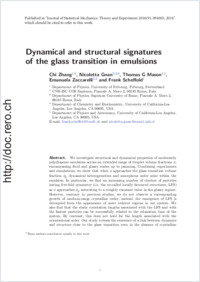Dynamical and structural signatures of the glass transition in emulsions
- Zhang, Chi Department of Physics, University of Fribourg, Switzerland
- Gnan, Nicoletta CNR-ISC UOS Sapienza, Roma, Italy - Department of Physics, Sapienza University of Rome, Italy
- Mason, Thomas G. Department of Chemistry and Biochemistry, University of California-Los Angeles, USA - Department of Physics and Astronomy, University of California-Los Angeles, USA
- Zaccarelli, Emanuela CNR-ISC UOS Sapienza, Roma, Italy - Department of Physics, Sapienza University of Rome, Italy
- Scheffold, Frank Department of Physics, University of Fribourg, Switzerland
-
2016
Published in:
- Journal of Statistical Mechanics: Theory and Experiment. - 2016, vol. 2016, no. 9, p. 094003
English
We investigate structural and dynamical properties of moderately polydisperse emulsions across an extended range of droplet volume fractions phgr, encompassing fluid and glassy states up to jamming. Combining experiments and simulations, we show that when phgr approaches the glass transition volume fraction ${{\phi}_{g}}$ , dynamical heterogeneities and amorphous order arise within the emulsion. In particular, we find an increasing number of clusters of particles having five-fold symmetry (i.e. the so-called locally favoured structures, LFS) as phgr approaches ${{\phi}_{g}}$ , saturating to a roughly constant value in the glassy regime. However, contrary to previous studies, we do not observe a corresponding growth of medium- range crystalline order; instead, the emergence of LFS is decoupled from the appearance of more ordered regions in our system. We also find that the static correlation lengths associated with the LFS and with the fastest particles can be successfully related to the relaxation time of the system. By contrast, this does not hold for the length associated with the orientational order. Our study reveals the existence of a link between dynamics and structure close to the glass transition even in the absence of crystalline precursors or crystallization. Furthermore, the quantitative agreement between our confocal microscopy experiments and Brownian dynamics simulations indicates that emulsions are and will continue to be important model systems for the investigation of the glass transition and beyond.
- Faculty
- Faculté des sciences et de médecine
- Department
- Département de Physique
- Language
-
- English
- Classification
- Physics
- License
- License undefined
- Identifiers
-
- RERO DOC 278698
- DOI 10.1088/1742-5468/2016/09/094003
- Persistent URL
- https://folia.unifr.ch/unifr/documents/305266
Statistics
Document views: 96
File downloads:
- sch_dss.pdf: 159
